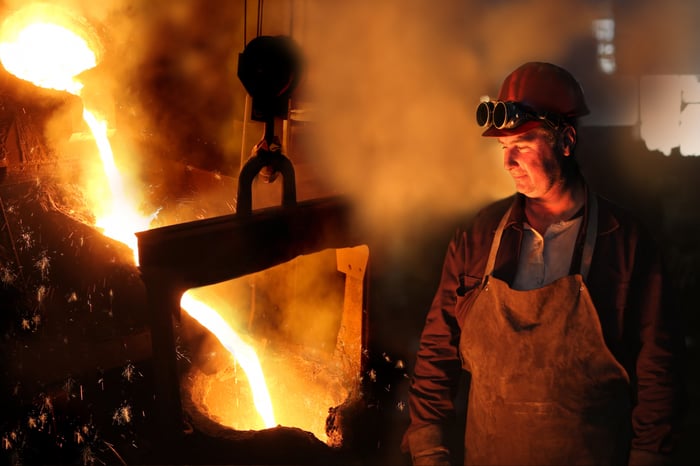As a new administration gets under way in the United States, one of the big expectations is that infrastructure spending will get a boost. Given the low grades awarded to the U.S. in this area by civil engineers, that would be a good thing for both the country and the companies that supply key products, like steelmakers. But all steel companies are not created equal, and these two steel stocks have an important long-term advantage.
The big players
There are four sizable steel companies in the United States: iconic United States Steel (X -0.49%), industry giant Nucor (NUE -1.04%), consolidator Cleveland-Cliffs (CLF -1.79%), and upstart Steel Dynamics (STLD -2.06%). The biggest thing separating these companies is the way they make steel.

Image source: Getty Images.
The first camp employs blast furnaces, an older technology that creates primary steel. It uses iron ore and coal and requires material scale to be profitable. This is largely what backs the steel operations of U.S. Steel and Cleveland-Cliffs. In fact, Cleveland-Cliffs' current business was created when the company, historically a steel industry supplier that produced iron ore, bought AK Steel and then late last year bought U.S. steel-making assets from global steel giant ArcelorMittal. These purchases created a giant steel maker and help ensure that Cleveland-Cliffs has customers for its iron ore. To be fair, the company is also a major supplier to other steel companies, including Nucor, but acquiring some of its customers clearly helps ensure continued overall demand.
The second camp, which includes Nucor and Steel Dynamics, uses electric arc furnaces. This is a more modern steel making technique that, as its name implies, uses electricity to produce the metal. Also integral to the process is scrap metal, with both Nucor and Steel Dynamics operating sizable scrap businesses. Electric arc mills tend to be smaller and more flexible than blast furnaces, allowing them to adjust more quickly to changes in demand. Notably, they can remain profitable even during periods of relatively weak overall demand. In fact, U.S. Steel has been looking to upgrade its production methods in this direction, recently buying a small steel maker so it could get access to a brand new electric arc mill to help balance out its blast furnace production.
The difference in numbers
The technology differences here are very important. Comparing the earnings trends of U.S. Steel -- the only blast furnace-based company with a long enough record to examine -- with Nucor and Steel Dynamics will help explain. While steel is always a cyclical industry, with performance tending to rise and fall along with economic activity, U.S. Steel's earnings are much more volatile than those of Nucor and Steel Dynamics, as the chart below shows.
X EPS Diluted (Annual) data by YCharts
Against that background, it shouldn't be shocking to see that electric arc-based Nucor and Steel Dynamics have histories of relatively strong and consistent margins, shown in the two charts below. That consistency translates into other benefits for shareholders -- for example, Nucor has increased its dividend annually for 47 consecutive years. Steel Dynamics, a much younger company started by former Nucor employees, has increased its dividend each year for a decade. U.S. Steel pays a token dividend of just a penny a share each quarter, after cutting its dividend in 2020.
X Operating Margin (TTM) data by YCharts
This isn't meant to suggest that U.S. Steel and Cleveland-Cliffs can't make large amounts of money -- when steel is in high demand and their mills are working at full capacity, this pair can be very profitable. In fact, at high capacity rates, blast furnaces are probably the cheapest way to produce steel. But, as noted, the industry is cyclical, so the good times invariably have to be juxtaposed against the lean times. Electric arc mills are simply more consistent performers over time. And that adds up to better long-term performance for investors.
Stick with quality
Since the start of 2021, Cleveland-Cliffs' stock is up 27%, and U.S. Steel's shares have advanced an incredible 42%. That's largely driven by the expectation of higher infrastructure spending, which increases demand for steel and lets these companies run their mills at higher capacities. The shares of Nucor and Steel Dynamics are up just 9% and 13%, respectively. Their businesses will benefit from rising demand, too, but not to the same degree because they are already performing relatively well.
Before you jump aboard hot steel stocks, however, it's important to understand the businesses that back the companies here. Yes, the two blast furnace-based mills will benefit more from an industry upturn. But that benefit will likely be fleeting given the cyclical nature of the steel sector. Most long-term investors would be better off sticking with Nucor and Steel Dynamics, both of which have more consistent core businesses built on electric arc mills. It's an advantage that may not seem important today, but when the sector turns lower, it will be.







